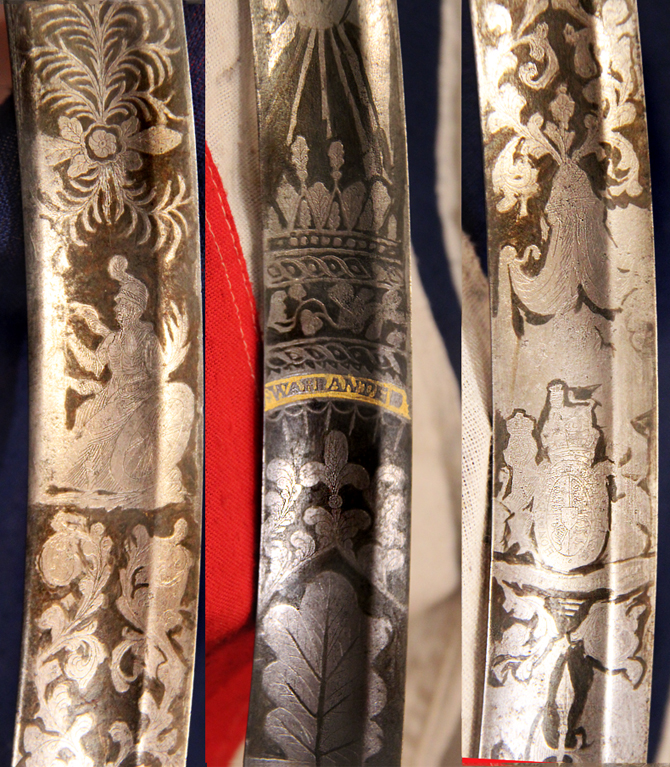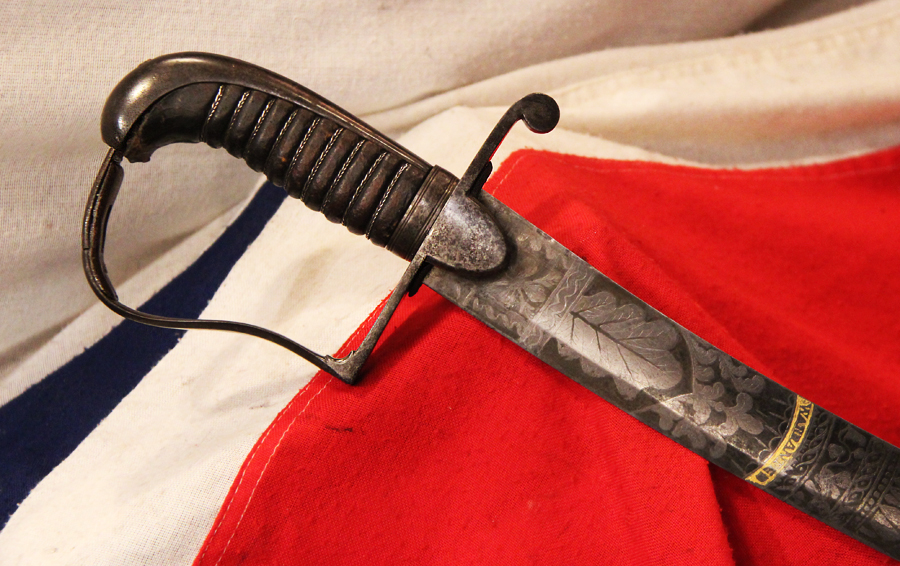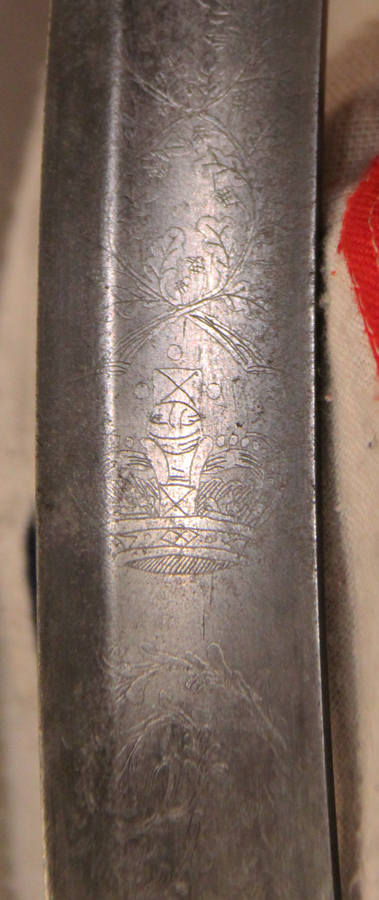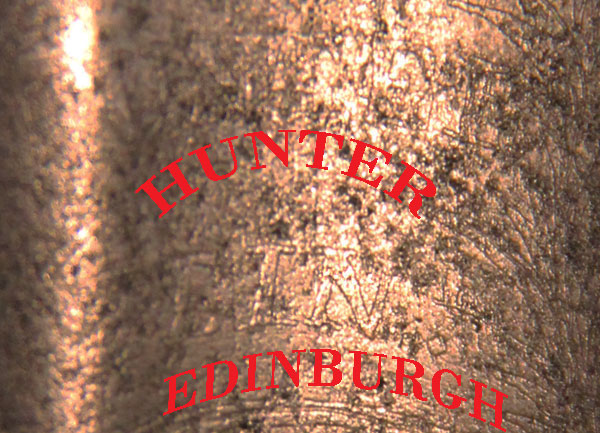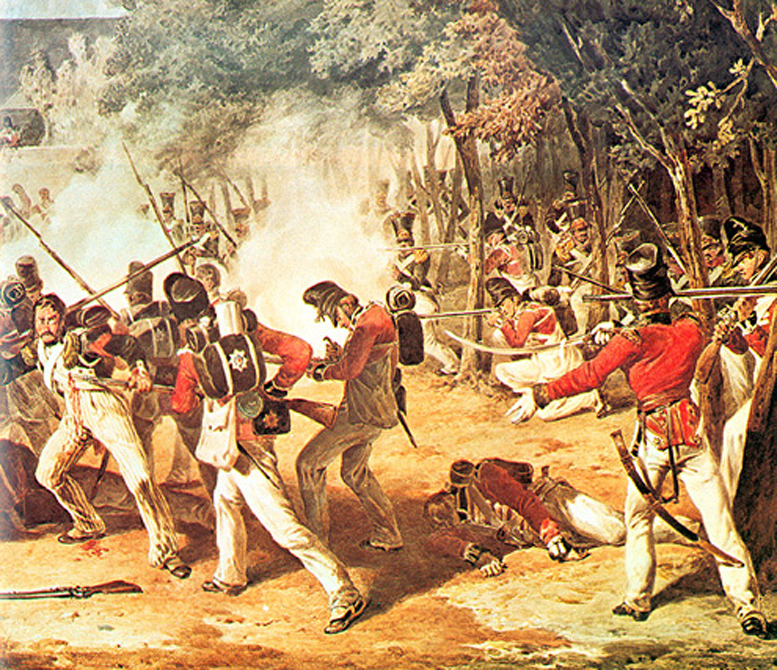A Stunning 1796 Scottish Flank Officer's Combat Sword, Napoleonic Wars, Peninsular & Waterloo Period. For Coldstream Guards, With One Of The Most Beautiful, Finest Quality & Unique Blade Engravings We Have Ever Seen. By Hunter of Edinburgh
Very likely a Coldstream Regiment of Foot Guards, flank company officer's sword for use in the Coldstreamers grenadier 'flank company' of the regiment. Almost certainly used by a Coldstream flank company officer in the Peninsular War and Waterloo, and even at Hougemont itself, for that, for us, there is little doubt. Each battalion of the British army included a light infantry company and a grenadier company; they were known as "flank companies" and were made up of the best soldiers in the battalion. During field operations they normally were pooled to form special corps of light infantry and grenadiers. This wondrous sword has a fully deluxe engraved blade, engraved and etched with royal crown, royal crest and cypher, a seated Brittania and an Angel blowing the trumpet of Victory, stands of arms, thistles and roses, with fine contra blueing, and fully intact to one blade face. Although fully engraved and etched on both sides, the obverse side is more worn, and has the blueing to that side worn away entirely. Possibly due to it being on display, hanging against a wall of a stately home or castle, for a century and a half or more. Custom made for its owner by Hunter of Edinburgh, and it was Hunter that was the dominant and near exclusive supplier of swords to all Coldstream guards regimental officers from before, and during, the Napoleonic wars. Also, the finest quality deluxe and extravagant nature of this blade is a typical example of the elaborate display of an elite Guards officer's status. The sword maker/retailer's name, Hunter, and his location, Edinburgh, is etched upon the obverse side of the blade, but very worn see photo 8 . In at least two seminal works of sword makers both Sword for Sea Service, and Swords and Sword Makers of England and Scotland it is clearly recorded that 'Hunter of Edinburgh' specifically supplied the officers of the Coldstream Guards from 1780 to at least 1810. The elite Coldstream Regiment saw extensive service in the wars against the French Revolution and in the Napoleonic Wars. Under the command of Sir Ralph Abercrombie, it defeated French troops in Egypt. In 1807, it took part in the investment of Copenhagen. In January 1809, it sailed to Portugal to join the forces under Sir Arthur Wellesley. In 1814, it took part in the Battle of Bayonne, in France, where a cemetery keeps their memory. The 2nd Battalion joined the Walcheren Expedition. Later, it served as part of the 2nd Guards Brigade in the chateau of Hougoumont on the outskirts of the Battle of Waterloo. This defence is considered one of the greatest achievements of the regiment, and an annual ceremony of "Hanging the Brick" is performed each year in the Sergeants' Mess to commemorate the efforts of Cpl James Graham and Lt-Col James MacDonnell, who shut the North Gate after a French attack. The Duke of Wellington himself declared after the battle that "the success of the battle turned upon closing the gates at Hougoumont". The night before the battle of Waterloo, Wellington sent MacDonnell with the guards to occupy the Chateau de Hougoumont. MacDonnell held this key position against overwhelming French attacks during the early part of the battle. When French troops were forcing their way into the courtyard, MacDonnell, aided by a sergeant, closed and held the gates by sheer physical strength. Chosen by Wellington for the award of £1,000 as the ‘bravest man in the British Army,’ MacDonnell insisted upon sharing the sum with his sergeant.
A painting by Dighton of the Coldstream Guards coming to the aid of the defenders. They fought their way into the chateau. Lieut-Col Daniel Mackinnon of the Grenadier Company has his back to us on the right. He was wounded in the knee but carried on until he became weak through loss of blood. He survived the battle and became commanding officer of the regiment in 1830.
Map of Hougoumont
From Wellington's viewpoint the three main buildings that formed landmarks on the battlefield were La Haye Sainte in the middle, Papelotte on the left, and Hougoumont on the right. The chateau of Hougoumont was a manor house and farm with ornamental garden, orchard and woods. The 1st Guards were posted on the ridge behind the chateau and some of them had been involved in a skirmish around Hougoumont on the evening of the 17th. But the defence of the buildings was given, initially, to the Light Companies of the Coldstream and Scots Guards under the command of Coldstreamer, Lieut-Col James Macdonnell, the personal choice of Wellington. They spent the morning barricading all the gateways into the enclosure of buildings, except for the north gate which had to remain accessible to supplies and reinforcements.
The first attack came from troops in Reille's Corps under the command of Jerome, who was ordered by his brother Napoleon, to take Hougoumont at all costs. He took the order literally and many Frenchmen died in the attempt, by the end of the day the number was 8,000. The first attack was repulsed by firing from within the chateau and outside. More attacks came, but thankfully without artillery which could have destroyed the walls of the enclosure. Those guardsmen who were still outside managed to withdraw into the chateau and the north gate was shut, but before it could be barricaded it was rushed by a party of 12 brave Frenchmen led by Lieutenant Legros, a large man with an axe. They barged in but all died fighting. Only a young French drummer was allowed to live. The closing and barricading of the gates was accomplished by Macdonnell and nine others.
Fighting Outside Hougoumont
Sir John Byng ordered three companies of the Coldstream Guards under Lt-Col Dan Mackinnon to go down and support the beleaguered garrison. They drove the French from the west wall and entered the enclosure. Napoleon himself became involved and ordered howitzer fire to be used. Incendiary shells were fired at the buildings and they caught fire, killing many of the wounded who were inside. Colonel Alexander Woodford entered the struggle with the remainder of the Coldstream Guards, leaving two companies on the ridge to guard the Colours. They fought their way into Hougoumont to reinforce the defenders. Woodford outranked Macdonnell but at first declined to take command away from him.
The End of the Battle
The situation became critical at one stage so that the King's German Legion were sent forward to counter-attack on the outside of the building. This effectively proved the last straw for the French who gave up their attempts to take Hougoumont. Woodford was commanding the garrison at the end of the battle when Wellington ordered a general advance to pursue the French. The force inside the enclosure ranged from 500 to 2000, but they managed to keep a whole French Corps occupied all day. The casualty figures for the Coldstream Guards on the 18th June was one officer and 54 other ranks killed, 7 officers and 249 other ranks wounded. Four men were unaccounted for. No scabbard
Code: 22157
2750.00 GBP



